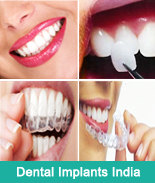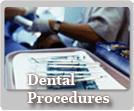 |
 |
|||||||||||||||
 |
|||||||||||||||
 |
|||||||||||||||
|
|||||||||||||||
Gum or Peridontal disorders
What is a periodontal or gum disorder?
The damage or decay of gums further causing the weakning of tooth roots is called a periodontal or gum disorder. Periodontal diseases range from simple gum inflammation to serious disease that results in major damage to the soft tissue and bone that support the teeth. In the worst cases, teeth are lost.
What are the causes of Gum or periodontal diseases?
Our mouths are full of bacteria. These bacteria, along with mucus and other particles, constantly form a sticky, colorless "plaque" on teeth. Brushing and flossing help get rid of plaque. Plaque that is not removed can harden and form bacteria-harboring "tartar" that brushing doesn't clean. This plaque further acts on the gums to damage them. Moreover gum diseases can also arise due to the following causes:
What are the symptoms of periodontal or gum diseases?
Symptoms are often not noticeable until the disease is advanced. They include:
- Bad breath that won't go away
- Red or swollen gums
- Tender or bleeding gums
- Painful chewing
- Loose teeth
- Sensitive teeth
How can periodontal disease be prevented?
Symptoms are often not noticeable until the disease is advanced. They include:
- Bad breath that won't go away
- Red or swollen gums
- Tender or bleeding gums
- Painful chewing
- Loose teeth
- Sensitive teeth
General tips to keep your teeth and gums clean
- Eat a balanced diet and limit between-meal snacks.
Antimicrobial mouth rinses and toothpastes reduce the bacterial count and inhibit bacterial activity in dental plaque, which can cause gingivitis, an early, reversible form of periodontal (gum) disease. ADA-Accepted antimicrobial mouth rinses and toothpastes have substantiated these claims by demonstrating significant reductions in plaque and gingivitis. Fluoride mouth rinses help reduce and prevent tooth decay. Clinical studies have demonstrated that use of a fluoride mouth rinse and fluoride toothpaste can provide extra protection against tooth decay over that provided by fluoride toothpaste alone. Fluoride mouth rinse is not recommended for children age six or younger because they may swallow the rinse. Consumers should always check the manufacturer’s label for precautions and age recommendations and talk with their dentist about the use of fluoride mouth rinse.
Gum or Peridontal Disorders India, Peridontal Disorders Treatment India, Peridontal Disorder Treatment Mumbai India, Gum Disorder Treatment India, Gum Disorder Treatment Mumbai India, Gum Diseases India, Gum Diseases Mumbai India, Gum Disorders Doctors India, Peridontal Disorder Doctors India, Gum Disorder Doctors Mumbai India, Peridontal Disorder Doctors Mumbai India, best medical treatment
|


